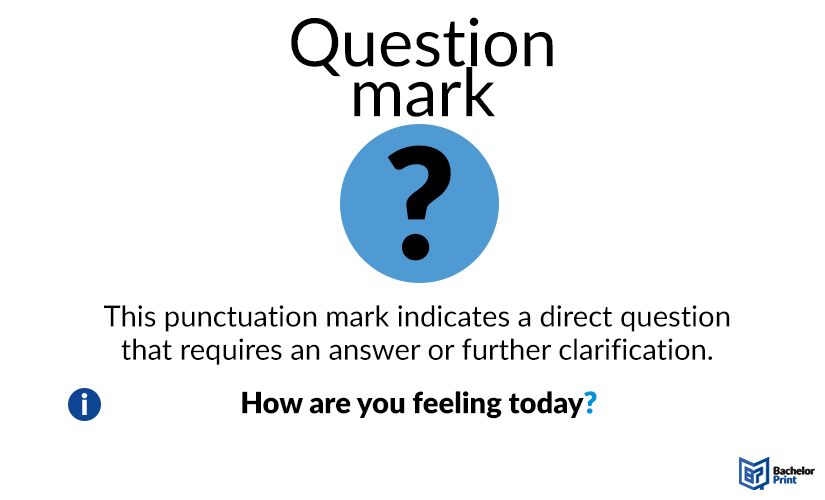
Question marks represent pivotal symbols within language rules of punctuation. They serve as cornerstones in written communication, marking the end of interrogative sentences, signaling inquiry, and encapsulating the curiosity and quest for knowledge inherent to human discourse. Understanding the application and rules for question marks is essential for effective communication, underscoring its significance in both formal and informal exchanges across diverse linguistic landscapes.
Definition: Question marks
A question mark can be defined as a punctuation symbol that is placed at the end of a sentence or phrase to indicate that the statement is an inquiry or straightforward question. This symbol is also referred to as the interrogation point or note of interrogation. It resembles a hooked line and has a dot at the bottom (“?”). Question marks serve as an integral component of grammar and syntax in virtually all languages, providing clarity and structure to written communication.
Primarily, question marks imply that information or clarification is needed. In this capacity, question markers prompt engagement from the reader, inviting them to consider and respond to the query posed by the author. In addition to their general interrogative function, they also convey nuances of tone and emotion. Based on how a question is phrased, along with the placement and intonation, they can convey various sentiments like curiosity skepticism, surprise, or urgency. Using multiple ordinary question marks or double question marks (“??”) instead of a single question mark might indicate heightened intensity or emotion.
Essentially, question marks are employed at the end of direct questions but never occur after indirect questions, statements expressing uncertainty, or rhetorical questions where no answer is expected.
Moreover, combinations of question marks with other conjunctions or punctuation marks, like commas, exclamation points, or quotation marks, are common scenarios and depend on the sentence structure and context in which the question is posed.

Types of question marks
While there is typically only one standard question mark in most writing systems, there are variations in style and usage in different contexts and languages, depending on the type of question. The following gives an overview of question mark usage in other forms and contexts with examples for a better understanding.
Inverted question marks (“¿”), also called inverted opening question marks, are primarily used in Spanish and some other languages that derive from Latin. They are typically placed at the beginning of a sentence to indicate that the statement is a question. In Spanish, inverted question marks act as a counterpart to the standard question mark function (“?”) used at the end of an interrogative sentence in languages like English. The inverted question mark, as implied in the term inverted opening question mark, is placed at the beginning of the question, whereas the standard question mark is at the end.
Arabic writing goes from right-to-left, and so do the questions. Thus, compared to the standard question marks, the Arabic script uses mirrored question marks (“؟”), which is why it can be referred to as the Arabic question mark, to visually adjust to the writing direction. Just like in English with the left-to-right question, Arabic question marks are placed at the end of a sentence to imply that it is interrogative.
When question marks are used with irony or a rhetorical question, the question isn’t seeking an answer but rather highlighting a point or the absurdity of a situation. In written text, irony or rhetoric can be hard to convey because we lack vocal tone or facial expressions. Therefore, punctuation like question marks or exclamation points can be employed to signal to the reader that the statement should be understood as ironic, sarcastic, or self-responded. Rhetorical question marks (⸮) are also mirrored question marks and referred to as percontation points. These mirrored question marks were suggested historically but never widely adopted.
Although not formally recognized in standard English punctuation rules, the double question marks (??) are informally used for emphasis, especially, in digital communication. Its interpretation can vary based on the context and the nature of the conversation. Typically, it is used to enhance the emotional intensity of a question, in other words, when a single question mark function doesn’t serve the meaning wholly. In some contexts, the first question might be rhetorical and the second question demands an actual answer to the previous sentence and therefore, ends in a double question mark.
The Greek question mark has the shape of a semicolon (;) but is used in the same way as the question mark in English. Its appearance can be confusing to those unfamiliar with Greek punctuation, as it shares its form with the semicolon used in Latin.
Similar to the double question mark, the interrobang (‽) is a non-standard punctuation mark that combines the question mark (?) and the exclamation point (!). It is placed at the end of a sentence that expresses a question, emphasizing disbelief or surprise. In essence, it can convey a sense of one-word questions like “really?!” or “what?!” in scenarios where both a question and an exclamation are warranted. In other words, instead of using the question mark interrogation point “?!,” the interrobang offers a more expressive and compact form to denote rhetorical questions.

Question marks and quotation marks
The combination of question mark use and quotation marks is a common scenario in English writing. The placement depends on whether the question is part of a quotation or if the entire sentence, including the quoted portion, is a question. Essentially, it is imperative to determine whether the question mark logically applies to the statement that is enclosed by quotation marks.
The question mark is placed inside the quotation marks if the quoted statement itself is a question.
If the question mark applies to the sentence as a whole instead of the phrase within the quotation marks, the question mark must be placed outside the marks, indicating that the entire sentence is the question.
Sometimes the quoted material at the end of a sentence and the whole sentence itself are questions. In this case, keep a single question mark and place it within the quotation marks.
Question marks and parentheses
The rules here are similar to those of quotation marks. If the question mark only applies to the phrase within the parentheses, it is placed after the question and before the closing parenthesis.
On the other hand, if the question mark applies to the entire sentence, including the information provided in parentheses, the question mark must be placed at the very end of the sentence, outside the parentheses.
Direct and indirect questions
Direct questions vs. indirect questions play a vital role in using question marks. Differentiation between direct and indirect questions appropriately can help you navigate different social and professional contexts more effectively, altering the tone, formality, and structure of the information being conveyed. When using question marks in direct and indirect questions, the main rules revolve around whether the sentence is structured as a question or a statement. The following provides an overview of question mark usage for the cases of direct and indirect questions.
Direct questions
Direct questions are straightforward questions that ask for information or clarification. These are punctuated with an internal question mark.
Indirect questions
Indirect questions embed a question within a sentence, this can be another question or a statement, making them less direct and often politer. Due to their sentence structure, they do not always need a question mark. Typically, they don’t require one as they are declarative, meaning they don’t demand an answer.
Multiple questions marks and exclamation points
In informal or casual writing, people often use multiple question marks or a combination of question marks and exclamation points to create emphasis. This style of writing is usually used when the statement is absurd, surprising, or exciting.
What to avoid in academic writing
Question marks in academic writing should be used accurately and sparingly, following explicit guidelines to maintain formality and clarity. While question marks are essential for direct questions, there are instances where they should be avoided.
Rhetorical questions are often discouraged in academic writing, due to their tendency of introducing ambiguity and subjectivity. Academic writing typically favors direct and concise statements that do not leave room for interpretation.
Framing statements of uncertainty as questions should be avoided in academic writing. They should be presenting your assertions confidently, backed by evidence.
When conveying information or making requests, it’s crucial to avoid indirect questions. Instead use declarative sentences or direct quotations from sources.
While questions can sometimes be used effectively in titles or headings to engage readers, overusing them can detract from the assertiveness and clarity expected in academic writing. Ensure that if a question is used in a title, it directly relates to the research question or aims to engage the reader critically with the content of the title.
It is pivotal to avoid including questions that presuppose a particular answer or perspective, as they can introduce bias. To maintain academic integrity and credibility, bias should be avoided and leave the paper neutral and objective.
Test Yourself!
Download the following practice sheet and its respective solution sheet and test whether you understood the most important rules of placing and using question marks.
FAQs
Using question marks in inquiry statements is important, as it helps the reader determine the nature of the sentence. In speech, it can be easy to determine which sentences are questions because of the tone used, but in writing, it can be difficult without the appropriate punctuation marks. You should use question marks whenever you write a direct question.
Here are three different cases for using a question mark:
- How many hours did it take you to get here?
- Was it a thought-through choice to leave the job?
- Did you make the flight on time?
The general rule in English writing is that we pause, stop, emphasize, or question. This is indicated by commas, periods, exclamation points, and question marks.
Although the indirect question is a question, it does not require a question mark, as they are embedded within declarative statements and typically, take on a different structure than a direct question.
